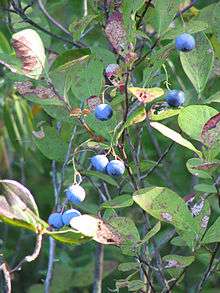Vaccinium caesariense
Vaccinium caesariense (New Jersey blueberry) is native to the Eastern United States. It is a species in the genus Vaccinium, which includes blueberries, cranberries, huckleberry, and bilberries.
| Vaccinium caesariense New Jersey blueberry | |
|---|---|
 | |
| Scientific classification | |
| Kingdom: | |
| (unranked): | |
| (unranked): | |
| Order: | |
| Family: | |
| Genus: | |
| Species: | V. caesariense |
| Binomial name | |
| Vaccinium caesariense | |
Range
Vaccinium caesariense is a native perennial plant in the Eastern United States, and is especially prominent in the New Jersey area, hence its common name New Jersey Blueberry. It is found in the coastal states from Florida to New Hampshire, almost always in wetlands.[1][2]
Description
Vaccinium caesariense has simple, small, oval green leaves during the summer and loses its leaves in the winter. This dicot exhibits a shrub growth habit, meaning this perennial, multi-stemmed woody plant is not likely to grow larger than 5 meters in height, particularly due to its numerous steming arrangements.
Cultivation
In commercial cultivation of Vaccinium caesariense, they are usually planted at the beginning of Fall or the end of Winter, with organic fertilizers such as manure compost and vermicompost.[3] As the plants develop woody stems irrigation is only needed during very dry periods. The cultivated plants are grown in soil that is accommodating to acidophilic plants.[3]
History
The blueberry is one of the few fruits eaten in North America that is native to the continent. Native Americans harvested the wild blueberries. Their special use in the plant is its function as a dye, coloring items. It is also known as a medication for ailing stomach issues.[4] Early Euro-American immigrant settlers began incorporating the fruit as an ingredient in foods and as a medicine.
In New Jersey
New Jersey has developed environmental and agricultural programs to protect and develop the New Jersey Blueberry, such as the Blueberry Plant Certification Program and the Phillip E. Marucci Center for Blueberry & Cranberry Research & Extension.
Proclamation
The New Jersey legislature issued a Proclamation for its native plant:[5]
- "Whereas, The highbush blueberry is indigenous to New Jersey, where it was first cultivated for commercial production, due to pioneering work by New Jerseyan Elizabeth White and Dr. Frederick Coville, who in the early 1900s dedicated themselves to the study, domestication, and breeding of blueberries at Whitesbog, in Browns Mills, New Jersey; and
- Whereas, the cultivation of highbush blueberries in New Jersey served as the basis for an entirely new agricultural industry; and
- Whereas, Blueberries taste good, are good for you, are high in fiber, vitamin C, and antioxidants, are sodium and cholesterol-free, are low in calories and provide medical and health benefits, including the prevention of cancer and heart disease; and
- Whereas, Blueberries are appreciated around the world, especially in the area of nutrition and the emerging field of nutraceuticals, where blueberries are known for their health benefits and medicinal properties; and
- Whereas, New Jersey ranks second in the nation in blueberry cultivation, producing 21% of the nation's total, with 38 million pounds grown annually on 8,000 acres, spanning seven counties in central and southern New Jersey; and
- Whereas, New Jersey is widely recognized as the blueberry capital of the nation, and the highbush blueberry, also known as the "New Jersey blueberry," is the ideal symbol of a delicious, nutritious, and healthful fruit ...
New Jersey hybrid
Although the species is still found growing in natural habitats, most of New Jersey's cultivated blueberries are a hybrid Highbush type. It was first developed by Elizabeth Coleman White, the daughter of a cranberry farmer, and introduced in Whitesbog, Burlington County, New Jersey. During harvest season, New Jersey farmers set up road-side farm stands and sell the fresh blueberries. The hybrid fruit, when frozen, maintains quality and taste upon thawing.[4]
References
- "Vaccinium caesariense". County-level distribution map from the North American Plant Atlas (NAPA). Biota of North America Program (BONAP). 2014. Retrieved 20 April 2019.
- New England Wildflower Society. "Vaccinium caesariense Mackenzie (New Jersey highbush blueberry)". Retrieved 20 April 2019.
- "New Jersey blueberry, Vaccinium caesariense Mackenzie". Gardening.eu. Retrieved September 13, 2010.
- "Vaccinium caesariense". PLANTS Profile. United States Department of Agriculture. Retrieved September 13, 2010.
- "State Fruit of New Jersey: Highbush Blueberry". State Symbols USA. Retrieved September 13, 2010.
